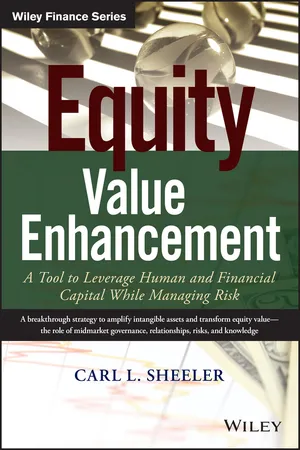
Equity Value Enhancement
A Tool to Leverage Human and Financial Capital While Managing Risk
- English
- ePUB (mobile friendly)
- Available on iOS & Android
Equity Value Enhancement
A Tool to Leverage Human and Financial Capital While Managing Risk
About this book
A detailed look at risk identification and value creation in private equity investment
Equity Value Enhancement ("EVE"): Governance, Risk, Relationships & Knowledge ("GRRK") provides the information and tools practitioners and business owners need to work with the multitude of intangibles ("GRRK") in equity investment decisions. The author engages readers with an insightful and brief claim: " Values are more than numbers." He then provides support for just how important human capital is to the value creation paradox. He doesn't stop there because ideas without definitive actions don't promote transformation. He further challenges the reader with: " If you don't think outside of the box, you're doomed to live in the box."
A user-friendly manual chock full of vignettes, suggestions and pithy commentary EVE is a must read for owners, officers, boards and advisors to derive understanding of business value drivers. This book teaches the reader how to conduct more intangible asset due diligence as well as what decisions and behaviors impact value. With more effective methods of risk identification, measurement, management, and mitigation ("IMMM"), trusted advisors and owners can establish a "working on the business" strategy to prioritize issues impacting a company's intangible assets – assets which almost inevitably create the largest component of value in flourishing companies. This focus also serves to reduce risk while leveraging human capital and operational effectiveness. This book challenges users of value enhancement and valuation services to demand greater intellectual rigor to best serve owners/investors of the United States' economic engine—the midmarket company. Therefore, readers are challenged to look beyond the common metrics and numbers. They are admonished to rely less on formulaic approaches and on software that can generate spurious opinions. The reader is called to action by the author, a US Marine Combat Officer veteran, to lead the change: "You burn the boats if you want to be sure you succeed taking the island."
Trillions of dollars of private equity are changing hands as Baby Boomer owners and investors seek greater liquidity and legacies while investors seek higher returns from direct investment in private companies. This book provides risk and human capital guidance removing some of the guesswork on valuation and value creation.
- Provide better evidence of value & equity discounts
- Identify and quantify risk and provide tools to manage it
- Inform better business management and investment decisions
- Create a more comprehensive valuation for equity investments
- Roadmap and strategy for enhancement of going concern value
Governance, Risk and Compliance ("GRC") management are hot topics in today's economic environment. The familiar financial metrics may not be providing adequate indications of value creation – the core principle of most shareholder investment expectation. To identify risk and work with it effectively, practitioners need an in-depth understanding of the forces at play. Equity Value Enhancement is a detailed, insightful guide for making better equity decisions.
Finally, the author puts his passion front and center by offering the reader the opportunity to invest in the human capital this book addresses by encouraging support of military veteran's with combat PTSD so they may be productive citizens with the leadership and business skills provided by our country's "Greatest Generation."
Frequently asked questions
- Essential is ideal for learners and professionals who enjoy exploring a wide range of subjects. Access the Essential Library with 800,000+ trusted titles and best-sellers across business, personal growth, and the humanities. Includes unlimited reading time and Standard Read Aloud voice.
- Complete: Perfect for advanced learners and researchers needing full, unrestricted access. Unlock 1.4M+ books across hundreds of subjects, including academic and specialized titles. The Complete Plan also includes advanced features like Premium Read Aloud and Research Assistant.
Please note we cannot support devices running on iOS 13 and Android 7 or earlier. Learn more about using the app.
Information
Chapter 1
Value ABCs
- Linked to strategy
- Clearly defined
- Understandable
- Easily measured
- Few in number
- Reported regularly
- Consistent follow-through
- Openly shared
- Predictive in nature
- Developed by everyone
- Team or unit based
- Tested against behavioral outcomes
- Assessed and modified regularly
- Linked to compensation
Capital and Risk
Table of contents
- Cover
- Title Page
- Copyright
- Table of Contents
- Dedication
- Foreword
- Preface
- Acknowledgments
- About the Author
- Author's Vision and Challenge
- Chapter 1: Value ABCs
- Chapter 2: Focus on Trusted Advisors
- Chapter 3: Focus on Business Owners
- Chapter 4: Risk in the Eye of the Beholder
- Chapter 5: The Role of Governance
- Chapter 6: The Role of Relationships
- Chapter 7: The Role of Risk: Financial- and Legal-Oriented Risk
- Chapter 8: The Role of Risk: Operational-Related Risks
- Chapter 9: The Role of Knowledge
- Chapter 10: Valuation versus Value Creation (GRRK)
- Chapter 11: Putting It All Together—Four Vignettes
- Recommended Reading
- Index
- End User License Agreement